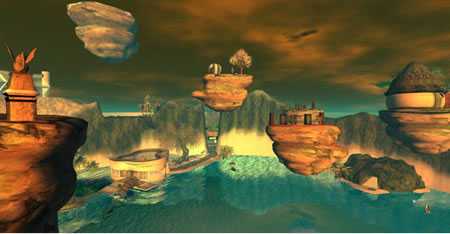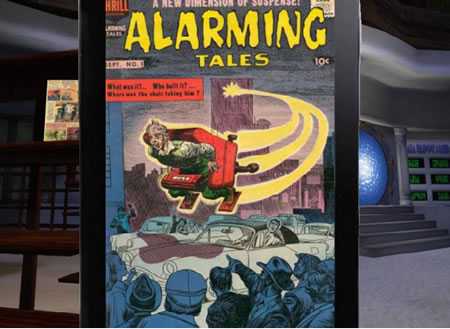A virtual repository aims to bring students together with an array of digitally-accessible material.
 The ancient Egyptians would be proud: With the increasing proliferation of online lesson plans and learning resources, virtual worlds are collaborating to build a virtual Library of Alexandria for higher education.
The ancient Egyptians would be proud: With the increasing proliferation of online lesson plans and learning resources, virtual worlds are collaborating to build a virtual Library of Alexandria for higher education.
The repository, aptly called Alexandria, is a Linden-based virtual library created to offer reference materials to support learning activities.
An article describing the virtual library, written by researcher Joseph M. Graham and Eva Comaroski of Wizardry and Steamworks Consulting Group, describes the library as a way of storing content digitally to eliminate burdens associated with costs, potential damage to physical books, and risks of losing a book. This method also helps preserve materials and avoids physical deterioration of the materials.
Different from Brick-and-Mortar, Just Online
Though digital resources offer the aforementioned benefits, the authors note that they don’t always offer the social experiences learning affords to students and teachers.
Recognizing this, Graham and Comaroski joined the social aspects of a brick-and-mortar library with the digital dissemination of learning materials.
“The result is a virtual world library that contains learning material for students, as well as providing a game-like multi-player experience that allows students to meet virtually in order to disseminate data together,” Graham and Comaroski note.
Alexandria is built on a platform similar to that of Second Life. The OpenSim platform, Graham and Comaroski explain, is a “game-like sandbox” allowing users to connect online and interact with one another. It also lets users build content in the virtual world without additional tools.
The virtual library contains collected literature from various sources with many literary works supplied by the Gutenberg project. Currently, the library spans multiple DDC (Dewey Decimal Classification) classes that are displayed in either Notecard or tablet format.
“Browsing a library with thousands of books becomes extremely difficult if there is no previous knowledge of the material sought after,” explain the authors. “Alexandria tries to address such shortcomings by providing much more than book covers, searching system or timeline-based triage. Alexandria is built by creating floating islands, each decorated and themed by the literature that is placed on those islands.

The authors believe these floating islands make it convenient to “just browse” the repository by following the decorations and artwork. For example, they explain, someone looking for wartime journalism will find a floating island decorated with sculptures of soldiers, a burning vehicle and perhaps a house on fire that contains the bookshelves with the corresponding literature.
In other words, say the authors, what makes this presentation of materials unique is that Alexandria does not address data archival in the traditional sense as much as it focuses on the delivery and display of that data. The technology of the virtual library uses a database as a backend, but includes the ability to feature “artistic hints and pointers in order to deliver thematic literature repositories at a glance.”

Graham and Comaroski offer an overview of the library in the article and point to a number of what they say are useful aspects:
- Backing up and restoring items is made easier given Alexandria’s virtual nature.
- Student and teacher interactions may be more comfortable in a virtual setting.
- Social interaction is promoted and encouraged, allowing students to collaborate and learn in the environment.

Users also can take books from the virtual repository to other “grids” where related simulations might occur. For instance, the authors note, a user can take a physics book from Alexandria and bring it to a physics simulation.
“The ability for anyone worldwide to access a library at any hour, have materials organized by their topics, as well as a way to talk to colleagues at any time, is something that very few real world libraries have,” Graham and Comaroski say.
“The additional help of automatic shelving and ability to instantly find any book (via the oracle platform) and instantly send a user to their requested material is also unparalleled in the real world, but easily possible in virtual space. Any catastrophic failure in Alexandria is virtually unheard of, with the ability to cloud store books and documents, and automatically re integrate them into the system, a feature that is not quite so easily available in the real world; if a fire hits, either the fire, or water damage from attempts to put out fire will occur, making losses inevitable.”
The authors plan further work on Alexandria, including the conversion of content to a widely recognizable format such as ePub by sending a requested book to an user via E-mail on a request popup of a shelf. Other ideas include expanding the library from primarily English to more languages, adding document uploading systems for teachers, and allowing students to send, receive, print, and/or edit documents.
More about the virtual library, including how to add materials, searching, indexing, and backing up data can be found in the article, here.
Alexandria library is part of the VIBE grid and hosted at the University of New Orleans. It can be accessed from any OpenSim world that is capable of establishing hyperlinks by writing on the local chat: secondlife:///repo.bio-se.info:9000/ and then opening the chat log and clicking the link. This will establish a hyperlink from the user’s current grid to the library at Project Alexandria and allow teleportation.
